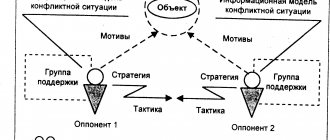At what stage is it easiest to resolve a conflict?
At first glance, nothing happened. But the snowball, from which an avalanche will later form, has already formed. Tension is gradually brewing between the future participants in the collision. If you don’t pretend that nothing is happening, at this stage the situation can still be neutralized with “a little bloodshed.” Neglect will not protect you from a quarrel. But the situation will develop on its own without the participation of opponents.
Gradually, the atmosphere heats up to such an extent that a small thing is enough: a look, a word, a gesture for a storm to break out.
Stage 2. Conflict
The conflict itself is an incident during which the majority loses self-control and habitually moves along a well-established pattern. Some prefer to shout and stomp their feet, others pull their heads into their shoulders and remain silent, others offer solutions, fourth go to court, and others give up.
All actions of this stage develop at the social, everyday and psychological level.
Examples of the conflict stage are origin (conversations in smoking rooms or offices). The growth of this phase can be tracked by a number of indirect signs. At the latent stage of the conflict, examples of signs can be given as follows: an increase in the number of absenteeism, dismissals.
This stage can be quite lengthy in duration.
The peak phase is the critical point of opposition.
At the peak stage of the conflict, the interaction between the warring parties reaches its utmost severity and intensity. It is important to be able to identify the passage of this point, since the situation of confrontation after its peak, as a rule, can be managed.
In a narrow sense, social confrontation refers to confrontation, the cause of which was disagreement among social communities in the justification of work activity, a general deterioration in the economic condition and status position, or in comparison with other groups, a decrease in the level of satisfaction with joint activities. A characteristic feature of social confrontation is the existence of an object of confrontation, the possession of which is associated with the frustration of individuals involved in social confrontation.
The main stages of social conflict: latent (hidden increase in discontent), peak of social tension (explicit expression of confrontation, active actions of participants), conflict resolution (reduction of social tension by overcoming the crisis).
The latent stage marks the stage at which conflict begins. Often it is not even noticeable to an outside observer.
Stages of conflict
Pre-conflict
It is the initial stage when hostility has not yet formed. There was just some nonsense where one spoke out and the other didn’t hold back. At first glance, there's nothing wrong with it. But the conflict is coming together piece by piece. The grains accumulate and tension begins to build between people. If you start acting right away, the discord can be neutralized. Neglecting this nuance will only complicate the situation.
Over time, the tension will reach such a level that an awkward look, gesture or word will be enough and an emotional explosion will occur, turning into a conflict.
Conflict
Discord refers to circumstances in which people lose control of themselves. Some may start screaming, others will get into fights, and there are also those who withdraw into themselves and simply endure everything. Including people who go to the courts for help, or try to find common ground in order to get rid of a problematic situation. These actions depend on the character of the person and his life experience. The more educated the opponents, the higher the likelihood of ending a quarrel without the use of physical force.
The good news is that feuds don't last forever. When the main intensity of passions subsides, opponents simply go about their business, with their conclusions about what happened. In most cases, conclusions are made based on emotions, which is why they are not always considered as they should be.
Post-conflict
The situation is analyzed by its participants. Whether the desired result was achieved or not. If expectations are not met, conflict phobia may arise. A quarrel that occurs can completely destroy a relationship or, conversely, serve to strengthen it. In some cases, the destruction of relationships entails a series of new conflicts. While strengthening relationships, we can conclude that a quarrel does not entail anything terrible, since after it the relationship only strengthens.
A quarrel not out of nowhere has similarities with a living organism. It has the ability to progress, feeding on the emotions of the participants, creating a certain step towards development, experiencing recessions and increases in energy.
Internal conflict: causes, types and ways to get rid of it
Conflictologists divide the stages of conflict development into 3 stages:
- Pre-conflict contains 2 stages: origin and maturation.
- Enmity is divided into 3 stages: incident, conflict, development of circumstances.
- Post-conflict contains stage 1: consequences.
The main thing is to understand that in the enmity itself there is an opportunity to take control of emotions and use common sense to neutralize a meaningless conflict.
At what stage is it easiest to resolve a conflict?
It is necessary to take into account that the following factors play an important role in constructive conflict resolution:
- adequacy of conflict reflection;
- openness and efficiency of communication between conflicting parties;
- creating a climate of mutual trust and cooperation;
- determination of the essence of the conflict.
Let's consider each of these factors separately.
a ).Adequate perception of conflict
Very often, in a situation of conflict, we incorrectly perceive our own actions, intentions and positions, as well as the actions, intentions and points of view of our opponent. Typical perceptual distortions include:
"Illusions of one's own nobility".
Possibilities of conflict regulation at different stages of conflict development.
| № | Conflict stage | Contents of management (type of activity) |
| 1 | The emergence and development of a conflict situation | Forecasting, warning (stimulation) |
| 2 | Awareness of a conflict situation by at least one of the participants in social interaction | Prevention (stimulation) |
| 3 | The beginning of open conflict interaction | Regulation |
| 4 | Development of open conflict | Regulation |
| 5 | Ending the conflict | Permission |
Conflict forecasting is one of the most important activities of a management subject; it is aimed at identifying the causes of a given conflict in its potential development. The main source of conflict prediction is the study of objective and subjective conditions and factors of interaction between people, as well as their individual psychological characteristics. In a team, for example, such conditions and factors may be: management style, level of social tension, socio-psychological climate, leadership and microgroups and other socio-psychological phenomena. A special place in conflict forecasting is occupied by the constant analysis of both general and specific causes of conflicts.
Conflict prevention is a type of activity of a management subject aimed at preventing the occurrence of a conflict. In this case, based on the information received about the causes of the maturing unwanted conflict, active efforts are undertaken to neutralize the entire complex of factors determining it. This is the so-called forced form of conflict prevention. But conflicts can be prevented by generally effective management of the social system. In this case, conflict management (including prevention) is an integral part of the overall management process in this system. The main ways to prevent conflicts in organizations can be:
· constant concern for meeting the needs and requests of employees;
· selection and placement of employees taking into account their individual psychological characteristics;
· compliance with the principle of social justice in any decisions affecting the interests of the team and the individual;
· education of employees, formation of a high psychological and pedagogical culture of communication, etc.
This form of conflict prevention, unlike the previous one, can be called preventive.
· Conflict stimulation is a type of activity of a management subject aimed at provoking and causing conflict. Incentives are justified in relation to constructive conflicts. Means of stimulating conflicts can be very different: bringing up a problematic issue for discussion at a meeting, meeting, seminar, etc.; criticism of the current situation at the meeting; speaking with critical material in the media, etc. But when stimulating a particular conflict, the leader must be ready to manage it constructively. This is a necessary condition in conflict management; violation of it, as a rule, leads to dire consequences.
· Conflict regulation is a type of activity of a management subject aimed at weakening and limiting the conflict, ensuring its development towards resolution. Regulation as a complex process involves a number of stages that are important to consider in management activities
· Conflict resolution is a joint activity of its participants aimed at ending opposition and solving the problem that led to the conflict. Conflict resolution involves the activity of both parties to transform the conditions in which they interact, to eliminate the causes of the conflict. To resolve the conflict, it is necessary to change the opponents themselves (or at least one of them), their positions that they defended in the conflict. Often the resolution of a conflict is based on changing the attitude of opponents towards its object or towards each other.
- Basic methods of conflict resolution.
Conflict resolution – prevention of open forms of conflict accompanied by violent actions (wars, riots, etc.); resolving conflicts by eliminating the causes that cause them; formation of a new level of relations between the participants (reducing the level of hostility of the conflicting parties, transferring the conflict into the direction of searching for a joint solution to the problem).
Conflict resolution helps limit its intensity and scale. Modern theoretical and applied political science reveals a number of methods for resolving political conflicts
| Methods of Conflict Resolution | Methods of application |
| "Avoiding" conflict | Temporary withdrawal from the political arena, avoidance of meetings with the enemy, etc. |
| Substitution of conflict | Moving it to another plane |
| Confrontation | Tough, “revolutionary” decisions |
| Device | Actions, actions aimed at independently developing solutions to resolve the conflict by one of the parties, but satisfying both parties |
| Postponement | Temporary concession to a strong opponent |
| Reconciliation of the parties | Bringing positions closer together through an intermediary |
| Arbitration or Arbitration | Appeal to judicial authorities |
| Negotiation | The most common and promising way to resolve political conflicts |
| Alternative Conflict Resolution | The conflict is regulated by the participants themselves through mutual cooperation and reaching an agreement |
Each of these methods has a number of advantages, disadvantages and limitations. Typically, the most effective is the integrated use of various methods depending on the specific conditions and nature of the conflict. In any case, the choice of specific methods of settlement should ensure the prevention of the onset of a violent stage of the conflict; resolving the contradictions that caused the conflict; reducing the level of confrontation between the parties and moving to finding a joint solution to the problem. The most favorable outcome of conflict resolution is the achievement of consensus.
Methods:
· conflict avoidance. This method is the most common, but not always effective. But avoiding a conflict does not mean its final resolution. The very contradiction that led to the conflict remains.
· postponing the conflict. This means withdrawing from the political struggle in general, leaving one’s positions. This method is quite common in the practice of political struggle (conflict between political parties and their leaders, between branches of government and those who lead them, as well as between states). But, like the first method, this method does not lead to the final overcoming of the conflict. The party that has surrendered its positions, with the subsequent accumulation of forces and with a change in the situation in its favor, can resume its claims to the other side and try to regain what it has lost
· peaceful confrontation between the parties based on the rapprochement of their positions and interests through an intermediary. The role of a mediator can be performed by investigative and conciliation commissions, and recently conflict managers have taken part in resolving conflicts in some countries.
· arbitration. The conflicting parties voluntarily submit their contradictions for consideration to a third party, whose decision is binding on both parties. Arbitrators, when considering a conflict, are guided by the norms of international law, the constitutions of the parties that are in conflict and the norms of treaties. Scientists and political practitioners believe that this method of conflict resolution can help solve it for now, but over time it may resume.
· negotiation. Negotiations provide an opportunity to reach agreement; they open the way for cooperation between parties that are in conflict.
- Objective, objective-subjective and socio-psychological conditions for conflict prevention.
Conflict prevention activities can be carried out in four main areas:
1) creation of objective conditions that prevent the emergence and destructive development of pre-conflict situations;
2) optimization of organizational and managerial conditions for the creation and functioning of organizations is an important objective-subjective prerequisite for preventing conflicts;
3) eliminating the socio-psychological causes of conflicts;
4) blocking personal causes of conflicts.
Basic objective conditions
, contributing to the prevention of destructive conflicts:
1. Creating favorable conditions for the life of workers in the organization. Such conditions include:
• financial security of the family;
• the possibility of a person’s self-realization in professional activities;
• working conditions;
• relationships developing with subordinates, colleagues, bosses;
• human health;
• family relationships;
• availability of time for proper rest.
2. Fair and transparent distribution of material benefits in the organization’s staff.
3. Development of legal and other regulatory procedures for resolving typical pre-conflict situations.
Pre-conflict situations include:
• determination of wages;
• appointment to a vacant position if there are several applicants;
• transfer of an employee to a new place of work;
• dismissal of an employee.
4. Soothing material environment surrounding a person.
Material environmental factors that help reduce the likelihood of conflicts include:
1) convenient layout of working and living spaces;
2) optimal characteristics of the air environment, illumination, electromagnetic and other indicators;
3) painting the premises in soothing colors;
4) equipment of psychological relief rooms;
5) absence of annoying noises.
Towards objective-subjective conditions
conflict prevention include the following organizational and managerial factors:
1) structural and organizational – associated with the optimization of a workshop, plant, company, on the one hand, as an organization, on the other, as a social group;
2) functional-organizational – associated with the optimization of functional relationships between the structural elements of the organization and its employees;
3) personal-functional;
4) situational and managerial. Social and psychological conditions:
a balance of roles during interaction
• Maintaining a balance of interdependence in decisions and actions
• Imbalance of mutual favors
in the interaction of people is fraught with tension in their relationships and possible conflict
• Interacting with each other, to one degree or another they strive to maintain a balance of damage.
Causing damage disrupts the balance of interpersonal or intergroup interaction and can become the basis of conflict
• In addition, a balance between self-esteem and external assessment
- Main directions of conflict prevention.
Conflict management is a conscious activity in relation to it, carried out at all stages of its occurrence, development and completion by the parties to the conflict or a third party. Conflict management includes: Symptoms, diagnosis, prognosis, prevention, prevention, mitigation, settlement, resolution. Forecasting conflicts consists of making an educated guess about their possible future occurrence or development. Conflict prevention consists in organizing the life activities of subjects of social interaction in such a way that eliminates or minimizes the likelihood of conflicts arising between them. The goal of conflict prevention is to create such conditions for the activity and interaction of people that would minimize the likelihood of the emergence or destructive development of contradictions between them. Activities to prevent conflicts can be carried out by the participants in social interaction themselves, by the heads of organizations dealing with conflicts. It can be carried out in four main directions: creating objective conditions that prevent the emergence and destructive development of pre-conflict situations; optimization of organizational and managerial conditions for the creation and functioning of organizations is an important objective-subjective prerequisite for preventing conflicts; elimination of socio-psychological causes of conflicts; blocking personal causes of conflicts.
- Prerequisites and main forms of ending the conflict.
Ending the conflict
- this is the activity of the subjects of the conflict, based on the desire to resolve the conflict and the problem that led to it.
Prerequisites for conflict resolution: 1. Sufficient maturity of the conflict, expressed in visible forms of manifestation, identification of subjects, their manifestation of their opposing interests and positions, in the organization of conflict groups and more or less established methods of confrontation. 2. The subjects’ need to resolve the conflict and the ability to do so. 3. Availability of the necessary means and resources to resolve the conflict: material; political; cultural; finally, human. At this stage of development of the confrontation, a variety of situations are possible that encourage both sides or one of them to end the conflict. Such situations include: - a clear weakening of one or both parties or the exhaustion of their resources, which does not allow further confrontation; — the obvious futility of continuing the conflict and its awareness by its participants. This situation is associated with the belief that further struggle does not give advantages to either side and there is no end in sight to this struggle; - the revealed predominant superiority of one of the parties and its ability to suppress the opponent or impose its will on him; - the appearance of a third party in the conflict and its ability and desire to end the confrontation. The above situations are also associated with ways to end the conflict, which can also be very diverse. The most typical of them are the following: - elimination (destruction) of the opponent or both opponents of the confrontation; — elimination (destruction) of the object of the conflict; - change in the positions of both or one of the parties to the conflict; — participation in the conflict of a new force capable of ending it through coercion; — the appeal of the subjects of the conflict to the arbitrator and its completion through the mediation of an arbitrator; — negotiations as one of the most effective and common ways to resolve conflict. By its nature, the end of the conflict may be as follows. 1. From the point of view of realizing the goals of confrontation: - victorious; - compromise; - defeatist. 2. From the point of view of the form of conflict resolution: - peaceful; - violent. 3. From the point of view of the functions of conflict: - constructive; - destructive. 4. From the point of view of the effectiveness and completeness of the resolution: - completely and fundamentally completed; — postponed for some (or indefinite) time.
Basic forms of conflict resolution
: permission; attenuation; settlement; elimination; ending by escalating into another conflict.
The first two forms of completion are carried out by the parties to the conflict. Permission
requires the joint participation of opponents in changing their initial positions. This can happen through mutual concessions or mutual compromise between the warring parties or through the establishment of cooperation.
Attenuation
is a temporary and partial end to the conflict. The contradiction that caused the clash is not resolved, and tensions may remain between the opponents.
This form of completion leads to:
changing the priorities of the motives driving opponents; loss of significance of the object of the conflict situation; insufficient forces to continue the conflict or depletion of resources.
Conflict resolution and resolution are forms of completion that occur with the participation of independent parties. Settlement
can happen without the consent of the conflicting parties.
As a result of ongoing negotiations, third parties reduce the conflict to a compromise resolution and seek concessions from the main subjects of the conflict. Elimination
conflict is based on a radical change in the elements of the structure of the conflict. This is a fairly tough form of conflict resolution, but in some conflicts it is the only possible one.
Resolution methods for elimination:
– long-term temporary prevention of interaction between conflicting parties;
– ensuring the complete exclusion of interactions between opponents;
– liquidation of the conflict object;
– satisfaction of the interests of all subjects of conflict interaction.
Sometimes during conflict interaction a new object of conflict appears. If its significance for opponents is greater than the previous object, then their interaction develops into another conflict. This form of conflict resolution is possible both with independent joint actions of the conflicting parties, and with the participation of a third party in resolving the conflict.
With any form of conflict resolution, it is important to understand when the conflict can be considered completed.
- Criteria for completing a conflict.
Ending the conflict
- this is the activity of the subjects of the conflict, based on the desire to resolve the conflict and the problem that led to it.
Basic forms of conflict resolution
: permission; attenuation; settlement; elimination; ending by escalating into another conflict.
Basic criteria for ending the conflict
:
1) satisfaction of the conflicting parties with the results of completion;
2) cessation of opposition;
3) achieving the goal of one of the parties;
4) division of the object of conflict between opponents;
5) elimination of one of the parties to the conflict;
6) change in the position of one of the parties to the conflict.
- Technologies for effective communication and rational behavior in conflict.
By technologies of effective communication we will understand such methods, techniques and means of communication that fully ensure mutual understanding and mutual empathy of communication partners.
To understand the specific content of such technologies, it is important to keep in mind that communication itself, as a complex socio-psychological process, is characterized by three main content aspects: communicative, interactive and perceptual. Each of them has relative independence and provides certain goals for the subjects of communication. For example, the communicative aspect reflects the desire of communication partners to exchange information, the interactive aspect is manifested in the need for them to comply with established communication norms, as well as in their desire to actively influence each other in a certain direction, and the perceptual aspect expresses the need of communication subjects for mutual empathy, sympathy, empathy.
A special place in the content of technologies for effective communication in conflict is occupied by the goals of the conflict participants. First of all, this is due to a significant contradiction in the very process of such communication. On the one hand, rivals especially need to understand each other correctly. On the other hand, such mutual understanding is hampered by the lack of proper trust between them, their “closedness” towards each other, due to conscious or unconscious self-defense in a conflict. Therefore, to ensure constructive communication in a conflict, it is necessary to create an atmosphere of mutual trust in this process and to form a goal for cooperation. At the same time, it is important to remember the psychological law of communication, which in a simplified form states: Cooperation causes cooperation, competition causes competition.
The main content of technologies for effective communication in conflict interaction ultimately comes down to compliance with certain rules and norms of communication. Such rules and regulations are presented in large numbers in domestic and foreign literature. Here we present the most significant of them.
• Concentrate on the speaker and his message.
• Check whether you correctly understood both the general content of the received information and its details.
• Communicate to the other party in paraphrased form the meaning of the information received.
• While receiving information, do not interrupt the speaker, do not give advice, do not criticize, do not summarize, and do not be distracted by preparing an answer. This can be done after receiving information and clarifying it.
• Make sure you are heard and understood. Follow the sequence of information delivery. Without making sure that the information received by your partner is accurate, do not proceed to new messages.
• Maintain an atmosphere of trust, mutual respect, and show empathy for your interlocutor.
• Use non-verbal means of communication: frequent eye contact; nodding the head as a sign of understanding and other techniques conducive to constructive dialogue.
The process of effective communication between subjects of conflict interaction is directly related to their rational behavior in the conflict. It is known that a surge of emotions in the process of resolving a dispute is a bad “ally” and, as a rule, leads to an aggravation of the situation. Emotional excitement prevents opponents from understanding each other; it does not allow them to clearly express their thoughts. Therefore, managing emotions in conflict interaction is one of the necessary conditions for constructive resolution of the problem.
Technologies of rational behavior in conflict are a set of methods of psychological correction aimed at ensuring constructive interaction between conflict participants, based on self-control of emotions.
The process of effective communication between subjects of conflict interaction is directly related to their rational behavior in conflict, knowledge of the basic principles and rules of behavior.
The main prerequisites for rational behavior in conflict are:
· knowledge of the general principles of managing a conflict situation and the ability to use them to analyze it;
· the level of general theoretical knowledge about the essence of conflict, its causes, types and stages of development, which are formulated by conflictology;
· the ability, on this general theoretical basis, to analyze a specific pre-conflict situation, which in each individual case turns out to be unique and requires a special set of methods and means to resolve it;
· the degree of compliance of the selected methods for adjusting the current conflict situation with its specific content; this adequacy of the means used to the real situation depends not only on the depth of knowledge of the possible participants in the conflict, but also on their ability to rely on their experience and intuition.
The organization of rational interaction between the subjects of the conflict involves the use of a number of appropriate methods of both socio-psychological, organizational, and moral and ethical nature.
Let's consider socio-psychological methods aimed at adjusting thoughts, feelings and moods of the “S”-ts of conflict interaction.
· The consent method is associated with the involvement of opponents in joint practical actions to resolve the problem. In the course of their implementation, the field of common interests expands, opponents get to know each other better, get used to cooperation, and jointly resolve emerging problems.
· The method of benevolence, or empathy - empathy and sympathy, understanding the internal states of the opponent. It involves not only expressing the necessary sympathy, but also the opportunity to provide him with practical assistance. This method requires the exclusion of unmotivated hostility, aggressiveness, and impoliteness from relationships.
· A method of preserving the opponent’s reputation and respecting his dignity. Means an expression of due respect for his personality. By recognizing the dignity and authority of the opponent, we thereby stimulate the corresponding attitude of the partner towards our dignity and authority.
· Method of mutual addition. It involves relying on a partner’s abilities that we ourselves do not have. Taking into account and skillful use of not only the abilities, but also the shortcomings of opponents help strengthen mutual trust and respect, and foster cooperation.
· The method of non-discrimination requires the elimination of emphasizing superiority and any differences between them.
· Method of psychological stroking - supporting the opponent’s positive emotional states.
A fairly effective organizational method, especially at the first stage of organizing constructive conflict interaction, is non-contact communication, for example, in the form of letters or e-mail, since in conditions of emotional tension, direct contact is fraught with the possibility of a sharp aggravation of relations.
Of no small importance when organizing constructive conflict interaction is the correct assessment of signs of non-verbal information.
Organizing effective constructive interaction involves:
· Allocating special time for communication, conversation, discussion. In this case, it is often necessary to overcome the desire of the other party to avoid contact and resort to escape tactics. To achieve the goal, it is important to convince the other that overcoming differences is beneficial to him. At the same time, it is important not to bind the other side with any preliminary obligations, except for participation in the upcoming dialogue and excluding intimidation and threats during it, i.e. attempts at forceful pressure.
· Creating the necessary amenities for organizing interaction.
· Mutual development of constructive conditions.
· Determining the order in which they should be performed.
Among the various techniques and ways of organizing constructive interaction, one more thing should not be forgotten: a healthy sense of humor. Healthy and appropriate humor allows you to ease the severity of a conflict situation and unite people even where there is no longer any hope for reconciliation. This is due to the fact that with the help of humor, at least some commonality between opponents is revealed, a common understanding of what is funny for all people. But at the same time, it is necessary to remember one mandatory condition: both opponents must have a healthy sense of humor.
Compliance with a number of moral and ethical rules allows increasing the effectiveness and constructiveness of interaction.
· In morality there is not and does not exist an absolute truth and a supreme judge.
· When it comes to the ethical failures of others, one should not turn “moral flies” into “moral elephants.” When it comes to your own mistakes, you should do the opposite.
· In morality, one should praise others and make claims against oneself.
· The moral attitude of others towards us depends, ultimately, only on ourselves.
· When practically establishing moral norms, the main imperative of behavior is “start with yourself.”
· Particular attention should be paid to the golden rule of any communication: “Treat others the way you would like to be treated.”
The predominance of the emotional component over the rational and the process of conflict interaction, as a rule, leads to an aggravation of the situation. Emotional excitement prevents opponents from understanding each other; it does not allow them to clearly express their thoughts. Managing emotions in conflict interactions is one of the necessary conditions for constructive resolution of the problem that has arisen. The decisive role in managing emotions belongs to the methods of mental self-regulation.
· Relaxation (from Latin relaxatio - reduction of tension, relaxation.
· Self-hypnosis in the form of autogenic training (or autotraining). It is a method of mental self-regulation of states, based on the conscious self-suggestion of feelings of warmth, alleviating the severity of various organs and parts of the body.
· Self-hypnosis in the form of sensory reproduction. It is a method of mental self-regulation of states, based on the mental recreation in all details of pleasant images of a beautiful cozy place, landscape and your feelings while being there.
· Meditation (Latin meditatio - reflection, deliberation) is a method of mental self-regulation using mental actions aimed at bringing the human psyche into a state of deep concentration and self-immersion.
People who master these methods of mental self-regulation more effectively manage the manifestation of their emotions and, accordingly, more effectively build both communication and interaction in conditions of conflict. In mastering these techniques, meditation is the most difficult.
It must be emphasized that mastery of these techniques does not guarantee effective interaction, but only helps to form an internal attitude toward constructive behavior in conflict.
Along with methods of mental self-regulation, it is recommended to use methods of getting rid of anger to control the manifestation of emotions.
· Visualization - imagine yourself doing or saying something. “Grounding” is the representation of anger in the form of a beam of negative energy that enters you from a person or energy that is born in a conflict situation. Then you imagine that this energy from your body goes into the earth.
· Projection and destruction in the form of projection. This method consists of pouring out your anger and projecting it onto some imaginary screen. Then you take an imaginary ray gun and "shoot" him. (This gives vent to the desire for violent action). With each hit, your irritation lessens and eventually disappears altogether.
· Cleansing the energy field around you. To do this, you should stand or sit and make a series of movements with your hands over the tone, imagining that with these movements you are “cleansing” the energy shell around this part of the body. At the same time, you need to make yourself feel that you are extracting irritation or other negative emotions from yourself and then shaking them off.
The first rule is a calm reaction to your partner’s emotional actions. When your partner is in a state of emotional arousal, you should under no circumstances succumb to the psychological law of contagion and enter the same state.
The second rule is rationalization of emotions.
Involves the exchange of the content of emotional experiences in the process of communication/By communicating their grievances and experiences, partners receive relief. But such an exchange must be carried out in a calm manner. In the process of exchanging emotions during a conversation, partners realize the meaning of what is happening and thereby ensure further constructive development of the negotiation process.
At the same time, it should be emphasized the importance of understanding the reasons for your undesirable emotional reaction at the previous stage of communication or interaction. This will avoid negative emotions in subsequent stages.
The third rule is maintaining high self-esteem.
One of the reasons for unwanted emotional reactions of partners in the process of conflict interaction is often the underestimation of their self-esteem. The inadequacy of emotional behavior in this case is explained by one of the psychological defense mechanisms - regression. To eliminate emotional reactions, you should maintain a high level of self-esteem in yourself and your opponent.
- System analysis of conflicts.
in a broad sense - synonymous with a systems approach;
in a narrow sense - a set of methodological tools that are used to justify decisions on complex problems of various types.
Basic principles of systems analysis:
1) decision-making should begin with the formation of final goals;
2) consideration of the problem as a whole, as a single system, identifying the relationships of each particular phenomenon and their consequences;
3) identification and analysis of possible alternative ways to achieve the goal;
4) preventing the goals of individual units from conflicting with the goals of the entire program.
The principle of the systems approach involves:• Consideration of the phenomenon under study as a system, as a delimited set of interacting elements.• Determination of the composition, structure, organization of elements and parts of the system, detection of leading interactions between them.• Identification of external connections of the system, identifying the main ones.• Determination of the function system, its place and role among other systems.• Detection of patterns and trends in the development of the system.
The main procedure of system analysis is the construction of a general model that reflects all real situations that may arise in the process of implementing decisions, after which possible alternative courses of action are identified and the resource costs for each of the options are compared and undesirable external influences are clarified. System analysis is based on applied mathematical operations and methods (information systems, computers). This method is used when decisions have to be made under conditions of uncertainty.
When studying conflicts, the following main types of system analysis are appropriate: system-structural, system-functional, system-genetic and system-information.
Systemic-structural analysis of a conflict consists of considering it as a whole, consisting of a system of substructures, which in turn consist of elements that cannot be decomposed into substructures.
It includes the following stages: determining the spatio-temporal and substantive boundaries of the conflict as a whole; identifying the largest possible number of substructures and elements that make up the structure of the conflict; grouping elements into a reasonable number of substructures; establishing a hierarchy of substructures and elements in which lower levels are subordinate to higher ones; identifying all the main connections and relationships between elements, substructures and the conflict as a whole.
Systemic-functional analysis of a conflict consists of determining the external manifestations of its properties in the system of relations of the society or psyche in which the conflict develops, as well as identifying the nature of the impact and ways of influencing some elements and substructures of the conflict on others.
Systemic genetic analysis of conflict is aimed at studying the driving forces of evolution, development and dynamics of conflicts.
It consists in revealing the conditionality of conflicts by factors of the macro- and microenvironment, dependence on the subjective world of the participants in the conflict, and determining the hierarchy of causes that give rise to conflicts.
System-information analysis of conflict consists of identifying the role of information and its functions in the origin, development and completion of conflicts.
4
At what phase is it easiest to resolve a conflict?
Rivalry is advisable in extreme and fundamental situations, in case of lack of time and a high probability of dangerous consequences.
A compromise consists in the desire of opponents to end the conflict with partial concessions. It is characterized by the renunciation of some of the demands that were previously put forward, the willingness to recognize the claims of the other party as partially justified, and the willingness to forgive. Compromise is effective in the following cases: the opponent understands that he and the opponent have equal opportunities; the presence of mutually exclusive interests; satisfaction with the temporary solution; threats to lose everything.
Adaptation or concession is considered as a forced or voluntary refusal to fight and surrender of one’s positions.
Learn to distinguish between conflict and contradiction of interests.
Many people confuse conflict and quarrel, avoid it and are afraid of it. Differences in interests, contradictions, and clashes of needs are not conflicts. For example, if strangers argued in public transport about an open window, this is a difference of interests. But when the air temperature of the office air conditioner provokes disputes, a showdown is already a conflict. A clash of interests is the beginning. If you don't pay attention to it at the initial stage, it becomes a conflict.
What does understanding the conflict of interests provide?
- The ability to put yourself in another person’s shoes and understand why it is so important to him.
- The opportunity to explain your point of view not from the position of “I’m right”, but from the position of “why is this so important to me.”
How to distinguish a difference of interests from a conflict situation? Track your emotions. After all, conflict begins where a person experiences emotional stress and behaves inappropriately in relation to the current situation. Often this behavior is triggered by past experiences.
Take the empathy test
Develop effective tactics for different types of conflict.
Each of us has strategies for dealing with conflict situations, polished over the years. We often bring them from childhood. The simplest example: a child asks, the mother does not allow it, the child falls to the ground, cries, and receives. A pattern is fixed in the subconscious: if you want to get it, you need to be capricious.
Of course, over time, he will stop literally falling to the floor, but will defend his interests in a similar way. And he will get what he wants as long as those around him act like his mother - avoid loud conflict and give in. But sooner or later a person will find himself in front of an opponent who cannot be overcome by shouting and behavior from the position of a capricious child. Then - stupor . After all, he doesn’t know how to behave otherwise. This situation becomes the starting point for understanding the psychology of conflict and developing new behavior in an unfamiliar situation.
Different types of conflicts require different approaches . One thing you should do is to act tough, to act as a parent. In another, they are being capricious, pretending to be a small child (by the way, these strategies are more often used by women). The role of an adult gives more flexibility, because you can choose in which situation to fight, and in which to gracefully yield.
Giving in does not mean losing.
Ancient philosophers formed an interesting idea: “people are not frightened by conflicts themselves, but by what people themselves (participants) think about them.” People have an inherent need to be right, to win even in the most insignificant situation. But you can win in different ways. For example, don’t fight “to the last blood,” but give in to your opponent.
But you should take this step consciously . And the first thing you need to do is clearly explain to yourself: “why am I doing this?” and “what will I get from this?” Such an analysis of the situation is internal work from the position of a mature person. By giving in, you won't feel like a loser. But it should be remembered: when a person calls himself non-conflict, constantly gives in, he develops a feeling of infringement of his own interests. On the one hand, health and relationships are preserved. On the other hand, a feeling of dissatisfaction accumulates in the soul.
You also need to be able to give in wisely . After all, behavior in a conflict situation depends only on the level of intelligence and the willingness of opponents to resolve the situation. If avoiding an argument happens too often, causing irritation and painful memories, it’s worth understanding yourself. And ask: what can I do so that next time I don’t hide, but elegantly win the argument?
Take the selfishness test
Stop relying on past bad experiences.
Memory records unpleasant situations experienced in a special way. They are remembered not as dry facts, they are emotionally colored and attached to a certain image. For example: a person lived in difficult times of total shortage and formed in his head a collective image of a rude saleswoman. Today this man meets a woman who looks like the established image. What is he subconsciously waiting for? Rudeness, impolite attitude. And even the most harmless remark on her part will be answered aggressively. Because he communicates not with a person, but with his own idea of him.
The human brain is designed in such a way that it is more willing to record bad memories in the subcortex. Past bad experiences don't just make our lives miserable. He is correcting our relationship today. Therefore, it is worth clearly distinguishing when we are talking to a person, and when we are communicating with “people from the past.”
Understand that not all conflicts are solvable.
Opposite parties see and assess the situation differently. And this difference gets worse over time, alienating opponents from each other. A protracted conflict has 2 stages: struggle and dialogue. As long as the parties are focused only on fighting, the situation will not be resolved. Even if disputes are resolved in court.
An intractable conflict situation has obvious signs:
- It develops until the parties “let off steam.”
- One or both opponents do not have the skills to conduct conflict and concentrate all their energy not on the situation, but on the personal rejection of the partner.
- Conflict is a way of human life. This is how creative people, for example, live.
There is a solution to conflict situations that prevent the parties from living. As soon as opponents realize this, they begin to look for ways of reconciliation and agreement. Until this point, the parties should separate for a while or ask for help from a third party.










